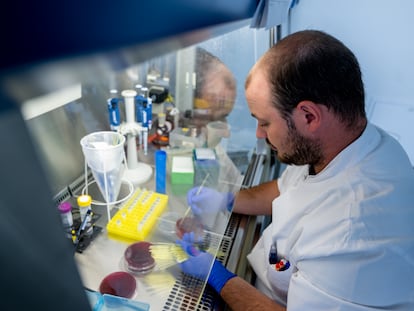In Iraq, only bacteria are emerging victorious from a series of wars
Bacterial resistance to antibiotics has run amok in the country after 40 years of armed conflict and the problem is spreading beyond its borders, experts warn
Since September 22, 1980, when then-president Saddam Hussein launched an offensive against neighboring Iran, Iraq has been through that conflict (1980-1988), the invasion of Kuwait (1990), two wars against US-led coalitions and subsequent occupation (1990-1991 and 2003-2011), as well as the violence meted out by Islamic State between 2014 and 2017. Neither Hussein, who was hanged in 2006, nor the United States, which left the country in a worse state than it found it, or the terrorists, won their respective wars. The only victor in all of them were bacteria, which have become resistant to most antibiotics, a danger that also knows no frontiers or territorial boundaries.
Bacterial resistance to antibiotics kills more people worldwide today than HIV/AIDS and malaria combined and it is estimated that by 2050, 12 million people will die every year due to super-bacteria. Although genetic analysis has shown that some bacteria had already developed defenses before Alexander Fleming discovered penicillin, the main cause of today is the misuse of such drugs, including anti-depressants. But another front in the fight against bacteria has been opened and there too the battle is being lost: wars. And aside from Palestine, no country has seen as many waged on its territory in recent history than Iraq.
A group of researchers led by American University of Beirut microbiologist Antoine Abou Fayad has reviewed the evolution of bacterial resistance in Iraq. There is not much data available from the eight-year-long conflict with Iran but in their paper, published in the medical journal BMJ Global Health, they detail several studies carried out on Iranian soldiers who suffered wounds on the front lines, which had been colonized by resistant bacteria. The most common of these was Staphylococcus aureus, one of the deadliest if it coincides with another pathology and that features prominently on the World Health Organization (WHO) list of the most dangerous microbes for which finding new antibiotics is a matter of utmost urgency. Staphylococcus aureus has already developed resistance to methicillin and vancomycin.
“Bacterial resistance to antibiotics is always more aggressive and chaotic during conflicts”Antoine Abou Fayad, American University of Beirut (Lebanon) microbiologist
“Bacterial resistance to antibiotics is always more aggressive and chaotic during conflicts,” says Abou Fayad. “Different factors come into play: lack of microbiologists and nursing and medical staff, lack of various kinds of antibiotics, internally displaced people, and then there is heavy metal contamination. This can trigger antibiotic resistance in bacteria, as heavy metals can also kill them in a similar way.” These heavy metals abound in warfare: chromium, copper, lead, nickel and zinc are used to produce bullets, missiles, cannons and military vehicles. Meanwhile, lead, mercury, antimony, barium and boron form part of explosive charges. These elements also persist in the natural environment and can also be released in the destruction of buildings. Since the Vietnam War, it has been proven that “many bacterial species have been shown to have evolved resistance mechanisms to combat heavy metals’ toxicity,” the report notes.
According to the authors of the study the combination of all these factors - added to the quantity and diversity of wounds, the movements of displaced persons and refugees and conditions in military field hospitals - causes a selective pressure that favors the emergence of superbugs.
When the first US soldiers wounded during the Iraq war of 2003-2011 (and also the war in Afghanistan, which began in 2001) were repatriated, the media and Western science became aware of the problem. US hospitals treated soldiers who had wounds that proved difficult to heal, even though the US military health authorities took precautions: debridement – the cleaning of wounds during combat operations – was very demanding and damaged tissue was cut away as far as necessary to avoid infection. In addition, antibiotic treatment was only administered after culture in order to choose the most appropriate treatment.
However, despite all these precautions, the US military could not avoid bringing the four horsemen of the bacterial apocalypse back from Iraq: Staphylococcus aureus, Pseudomonas aeruginosa, which is naturally resistant to a wide array of antibiotics, Klebsiella pneumoniae, one of the most unwanted visitors in emergency rooms, and the most feared of all, Acinetobacter baumannii. This latter superbug is at the very top of the WHO list due to its widespread antimicrobial resistance, was dubbed “Iraqibacter” by the US media. Of the over 50,000 US military personnel who were wounded in Iraq and Afghanistan, hundreds were carrying these bacteria when they were treated in US hospitals. Many soldiers underwent amputations not as a direct result of their wounds but because of bacterial infections, in particular A. baumannii, Pseudomonas aeruginosa or a combination of both. According to a 2018 report by the US National Center for Biotechnology Information: “One-third of combat casualties from Iraq and Afghanistan develop infections during their initial hospitalization.”
If that is the case in the world’s leading power, what is the situation in Iraq among civilians and military personnel? The authors of the study point out that there is no global data but there have been many partial studies carried out at specific hospitals. For example, a study in Baghdad of almost 500 people wounded in attacks and clashes with Islamic State militias during the first half of 2015 identified A. baumannii strains in 96 of them. In 87.5% of those cases, the bacteria were resistant to a dozen families of antibiotics. In Mosul, northern Iraq, work by Médecins Sans Frontières in a hospital set up in 2018 by the NGO showed that, in the first months of the center’s operation, 40% of those admitted had a bacterial infection. In a note from MSF, its antibiotic resistance advisor, Ernestina Repetto, claimed at the time: “Of the bacteria that could be isolated, the vast majority already demonstrated a pattern of multi-resistance, which automatically reduces treatment options.”
Medical science protocols state the first thing to do with a patient carrying a superbug is to isolate them. But although this was mandatory practice in US military hospitals, it did not prevent nosocomial infection (infections acquired during the process of receiving health care that were not present during the time of admission). There is no available data on what may have happened in Iraqi hospitals. Abou Fayad points out that the problem has not been contained within Iraq’s borders. “The discovery of the NDM-1 enzyme gene was in an Iraqi war-wounded patient who went to India seeking medical help,” he notes.
The New Delhi metallo-beta-lactamase 1 enzyme was discovered in 2009 in a strain of K. pneumoniae and makes the bacteria that generate it resistant to almost all antibiotics, including those used as a last resort such as carbapenems. Making matters worse is that this gene is jumping to other strains and species of bacteria via horizontal gene transfer.
Sign up for our weekly newsletter to get more English-language news coverage from EL PAÍS USA Edition
Tu suscripción se está usando en otro dispositivo
¿Quieres añadir otro usuario a tu suscripción?
Si continúas leyendo en este dispositivo, no se podrá leer en el otro.
FlechaTu suscripción se está usando en otro dispositivo y solo puedes acceder a EL PAÍS desde un dispositivo a la vez.
Si quieres compartir tu cuenta, cambia tu suscripción a la modalidad Premium, así podrás añadir otro usuario. Cada uno accederá con su propia cuenta de email, lo que os permitirá personalizar vuestra experiencia en EL PAÍS.
¿Tienes una suscripción de empresa? Accede aquí para contratar más cuentas.
En el caso de no saber quién está usando tu cuenta, te recomendamos cambiar tu contraseña aquí.
Si decides continuar compartiendo tu cuenta, este mensaje se mostrará en tu dispositivo y en el de la otra persona que está usando tu cuenta de forma indefinida, afectando a tu experiencia de lectura. Puedes consultar aquí los términos y condiciones de la suscripción digital.
More information
Archived In
Últimas noticias
Most viewed
- Reinhard Genzel, Nobel laureate in physics: ‘One-minute videos will never give you the truth’
- Oona Chaplin: ‘I told James Cameron that I was living in a treehouse and starting a permaculture project with a friend’
- Pablo Escobar’s hippos: A serious environmental problem, 40 years on
- Charles Dubouloz, mountaineering star, retires at 36 with a farewell tour inspired by Walter Bonatti
- Why we lost the habit of sleeping in two segments and how that changed our sense of time











































